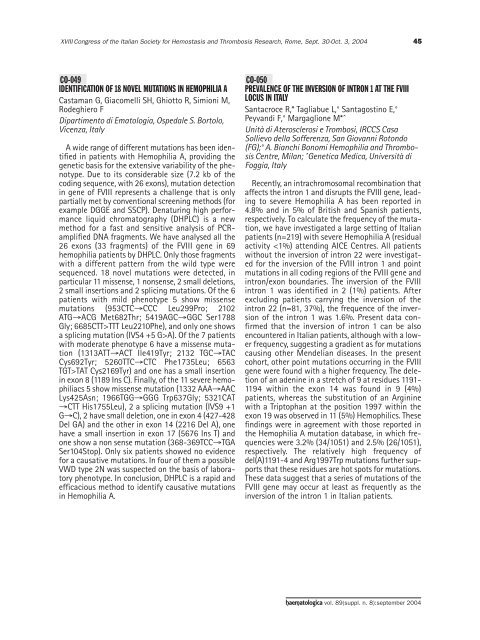Haematologica 2004;89: supplement no. 8 - Supplements ...
Haematologica 2004;89: supplement no. 8 - Supplements ...
Haematologica 2004;89: supplement no. 8 - Supplements ...
- No tags were found...
You also want an ePaper? Increase the reach of your titles
YUMPU automatically turns print PDFs into web optimized ePapers that Google loves.
XVIII Congress of the Italian Society for Hemostasis and Thrombosis Research, Rome, Sept. 30-Oct. 3, <strong>2004</strong>45CO-049IDENTIFICATION OF 18 NOVEL MUTATIONS IN HEMOPHILIA ACastaman G, Giacomelli SH, Ghiotto R, Simioni M,Rodeghiero FDipartimento di Ematologia, Ospedale S. Bortolo,Vicenza, ItalyA wide range of different mutations has been identifiedin patients with Hemophilia A, providing thegenetic basis for the extensive variability of the phe<strong>no</strong>type.Due to its considerable size (7.2 kb of thecoding sequence, with 26 exons), mutation detectionin gene of FVIII represents a challenge that is onlypartially met by conventional screening methods (forexample DGGE and SSCP). Denaturing high performanceliquid chromatography (DHPLC) is a newmethod for a fast and sensitive analysis of PCRamplifiedDNA fragments. We have analysed all the26 exons (33 fragments) of the FVIII gene in 69hemophilia patients by DHPLC. Only those fragmentswith a different pattern from the wild type weresequenced. 18 <strong>no</strong>vel mutations were detected, inparticular 11 missense, 1 <strong>no</strong>nsense, 2 small deletions,2 small insertions and 2 splicing mutations. Of the 6patients with mild phe<strong>no</strong>type 5 show missensemutations (953CTC→CCC Leu299Pro; 2102ATG→ACG Met682Thr; 5419AGC→GGC Ser1788Gly; 6685CTT>TTT Leu2210Phe), and only one showsa splicing mutation (IVS4 +5 G>A). Of the 7 patientswith moderate phe<strong>no</strong>type 6 have a missense mutation(1313ATT→ACT Ile419Tyr; 2132 TGC→TACCys692Tyr; 5260TTC→CTC Phe1735Leu; 6563TGT>TAT Cys2169Tyr) and one has a small insertionin exon 8 (11<strong>89</strong> Ins C). Finally, of the 11 severe hemophiliacs5 show missense mutation (1332 AAA→AACLys425Asn; 1966TGG→GGG Trp637Gly; 5321CAT→CTT His1755Leu), 2 a splicing mutation (IVS9 +1G→C), 2 have small deletion, one in exon 4 (427-428Del GA) and the other in exon 14 (2216 Del A), onehave a small insertion in exon 17 (5676 Ins T) andone show a <strong>no</strong>n sense mutation (368-369TCC→TGASer104Stop). Only six patients showed <strong>no</strong> evidencefor a causative mutations. In four of them a possibleVWD type 2N was suspected on the basis of laboratoryphe<strong>no</strong>type. In conclusion, DHPLC is a rapid andefficacious method to identify causative mutationsin Hemophilia A.CO-050PREVALENCE OF THE INVERSION OF INTRON 1 AT THE FVIIILOCUS IN ITALYSantacroce R,* Tagliabue L,° Santagosti<strong>no</strong> E,°Peyvandi F,° Margaglione M*^Unità di Aterosclerosi e Trombosi, IRCCS CasaSollievo della Sofferenza, San Giovanni Rotondo(FG);° A. Bianchi Bo<strong>no</strong>mi Hemophilia and ThrombosisCentre, Milan; ^Genetica Medica, Università diFoggia, ItalyRecently, an intrachromosomal recombination thataffects the intron 1 and disrupts the FVIII gene, leadingto severe Hemophilia A has been reported in4.8% and in 5% of British and Spanish patients,respectively. To calculate the frequency of the mutation,we have investigated a large setting of Italianpatients (n=219) with severe Hemophilia A (residualactivity
















